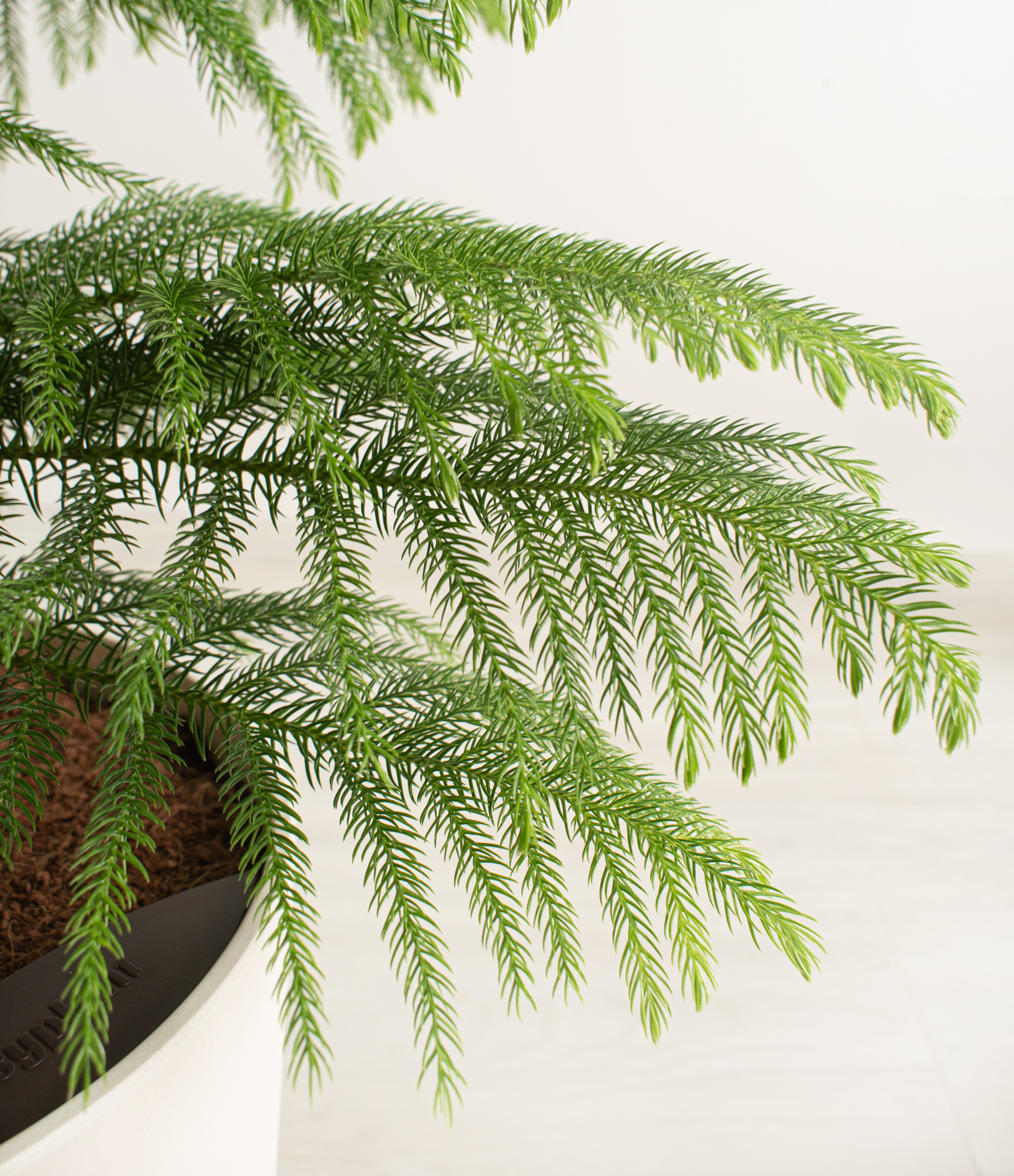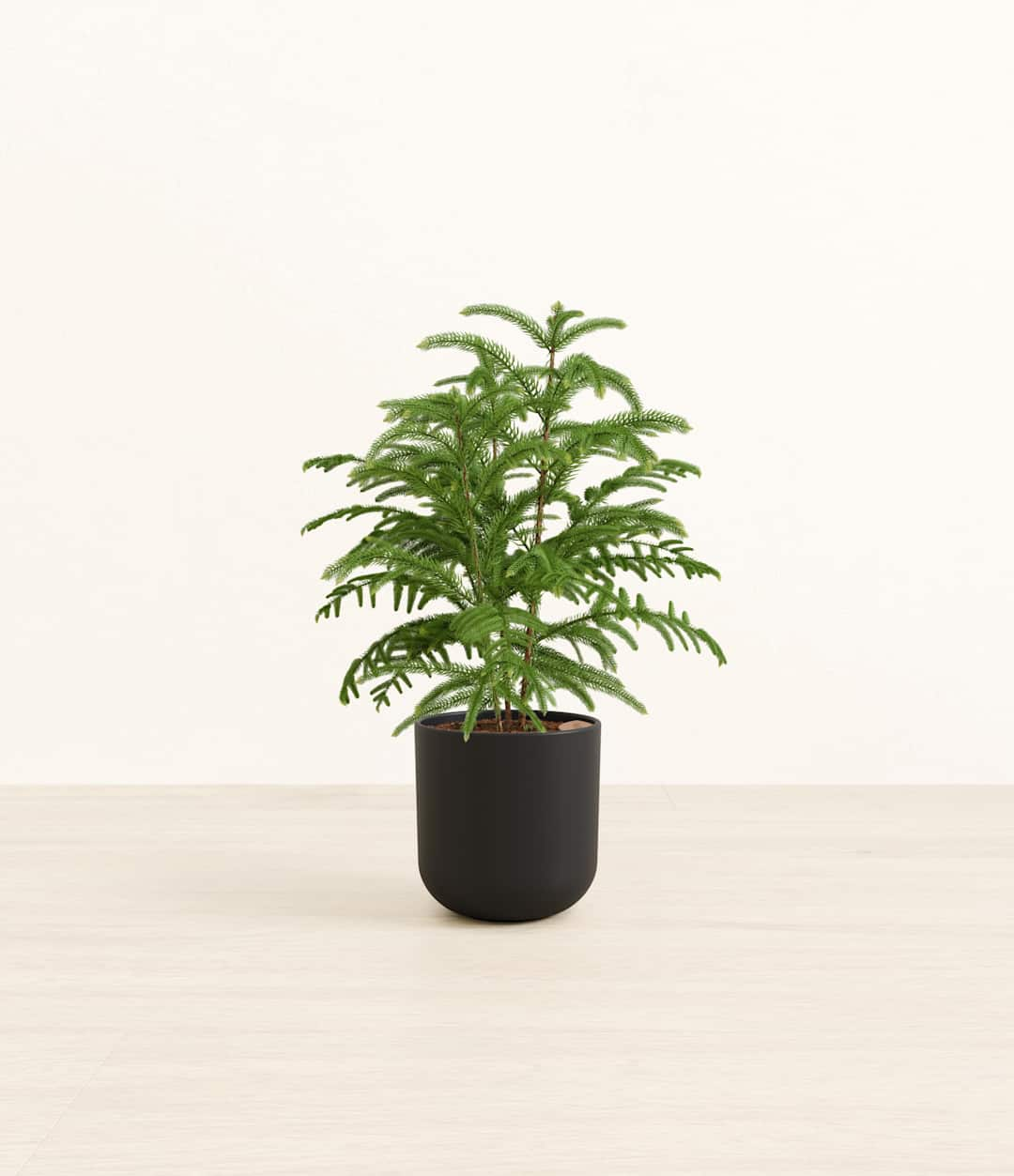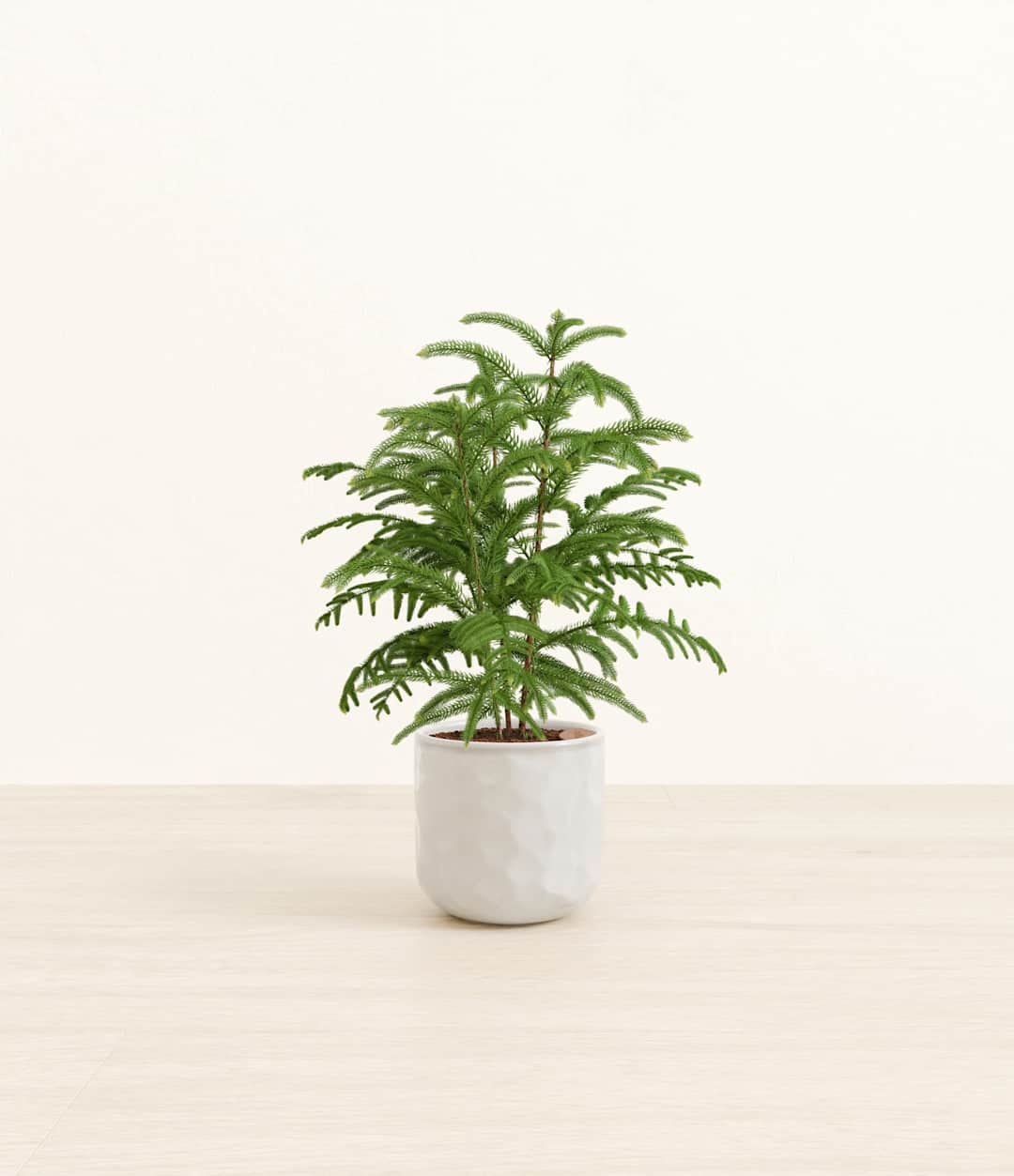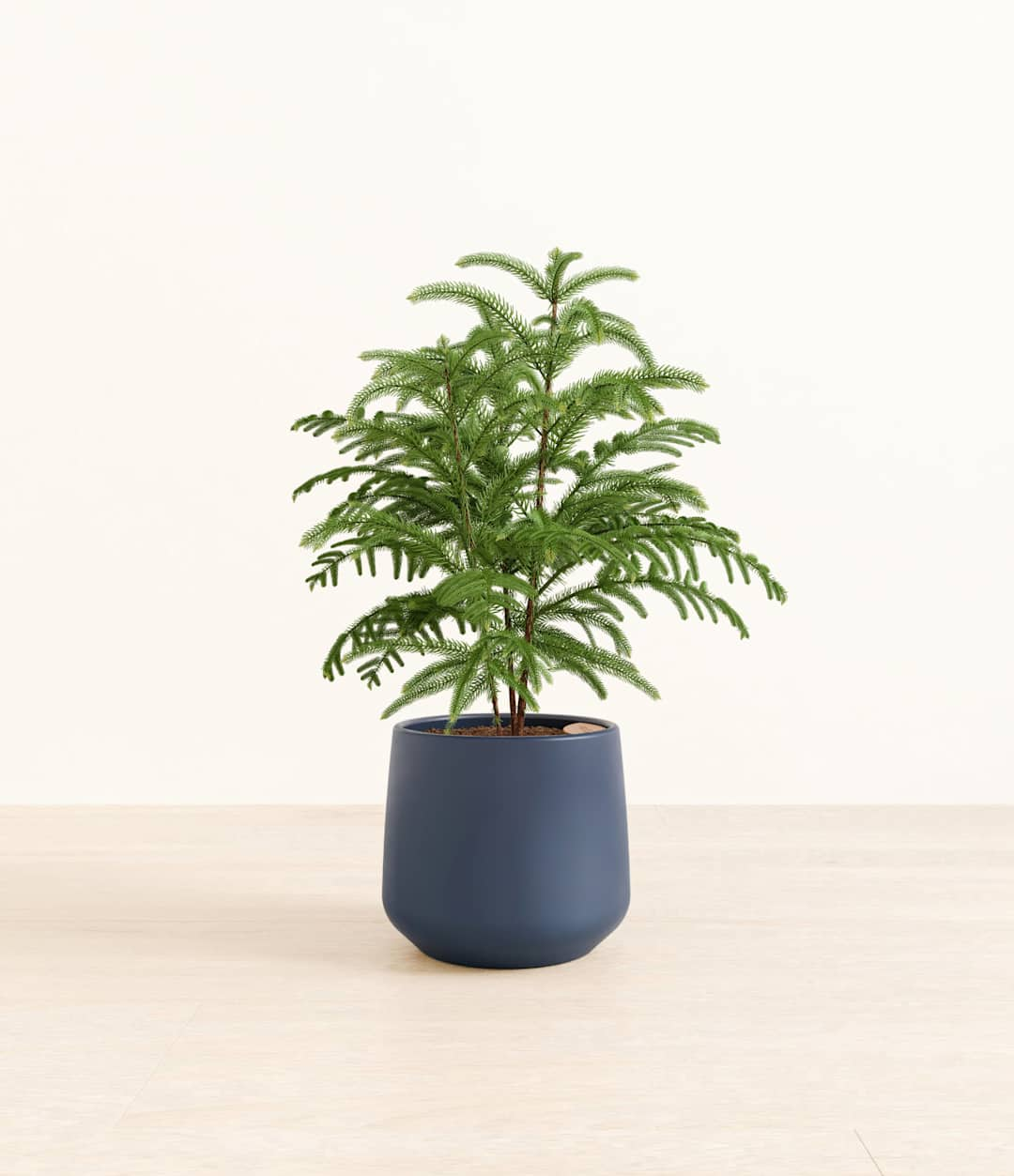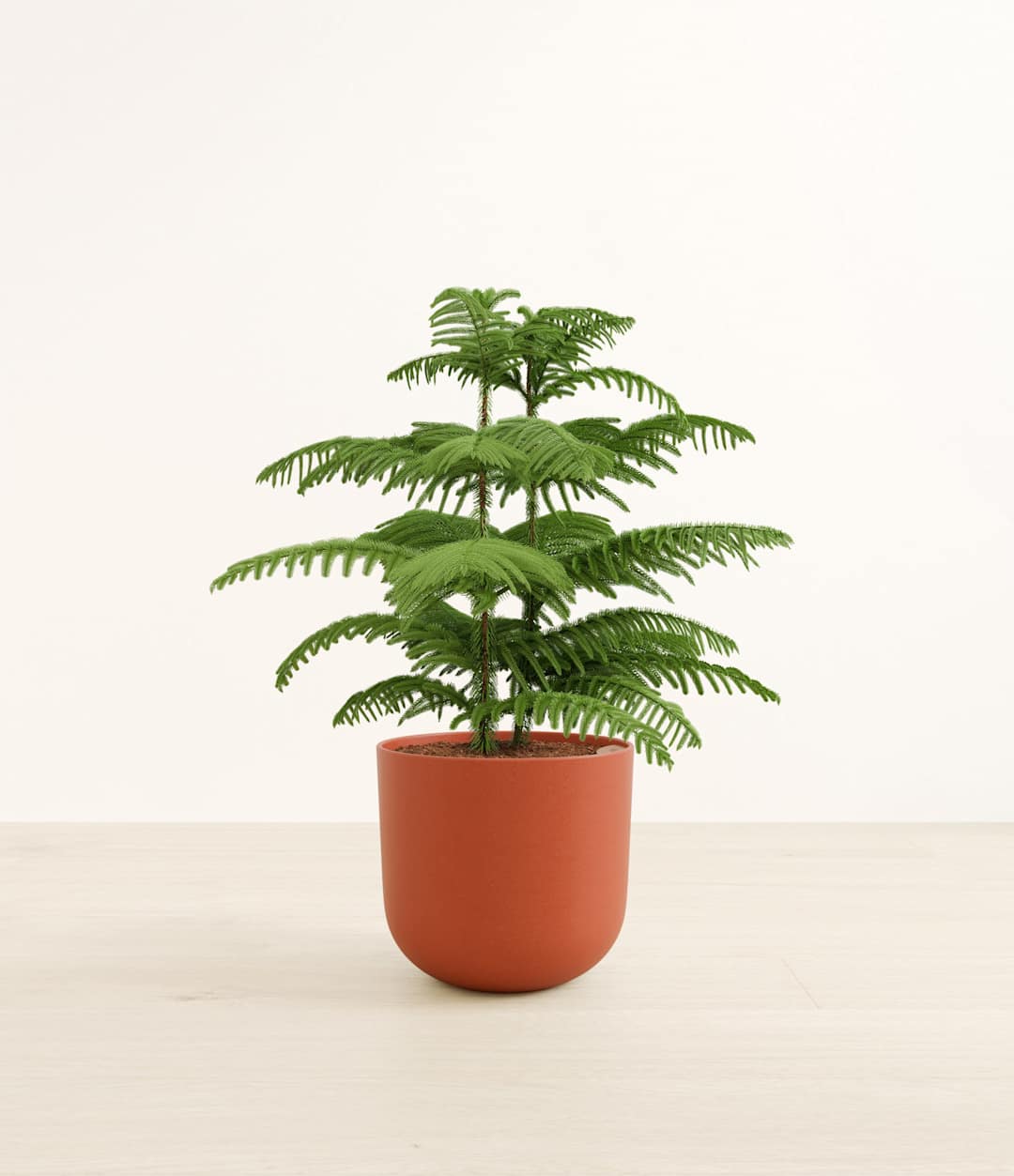How to care for Norfolk Island Pine
Shop this plantAbout Norfolk Island Pine
The Norfolk Island Pine, a tropical gem from the South Pacific, is a cherished plant among greenery lovers. Known for its versatility as a charming mini Christmas tree, its delicate, needle-like branches are equally enchanting year-round, ensuring any space remains stylish and spirited. Even stripped of holiday adornments, this plant's innate elegance and cheerful greenery bring a sense of calm and joy to any setting.
Other common names
- Christmas Tree
- Star Pine
- Australian Pine
- Triangle Tree
- House Pine
- Living Christmas Tree
- Polynesian Pine
- Araucaria heterophylla
How Often Should I Water My Norfolk Island Pine?
With easyplant, watering your Norfolk Island Pine is simple. Just make sure to check the easyplant reservoir once a month and fill it if empty and the top soil is dry, and you're all set!
Norfolk Island Pine Light Needs
Norfolk Island Pine grows best in a space with bright indirect light, where the sun rays are diffused, and can also adapt to spaces with bright direct light, where the sunlight streams inside directly. Avoid placing it in spaces with low light or spaces without natural sunlight.
When placed in a spot with direct light, it's important to monitor the intensity of the sun's rays, especially during the hot summer months. Too much direct sunlight can scorch the needles, causing them to brown and lose their lush green luster. A location near a window with sheer curtains is ideal as it provides ample light while protecting the plant from the harshness of the midday sun. If you notice the needles starting to pale or the plant becoming leggy, it may be a sign to move it closer to the light source.
Norfolk Island Pine Plant Care
During your Norfolk Island Pine’s first few days at home, it's natural for this tropical houseplant to undergo a period of adjustment. You may notice a leaf or two turning brown – this is typical as it acclimates to its new environment. Simply trim any wilted foliage, and your plant will be ready to flourish.
Once acclimated, your Norfolk Island Pine care routine is delightfully straightforward. This resilient plant bounces back quickly, ready to grow with vigor. To support its development, keep the pine's needles dust-free and turn the pot a quarter every month to ensure consistent light exposure, encouraging strong and symmetrical growth.
Should your indoor Norfolk Island Pine begin to outgrow its space, light pruning can help manage its shape and size, keeping it just right for your living area. With these care steps, the Norfolk Island Pine becomes more than a plant; it’s a statement piece that brings a year-round, cheerful green presence into your home.
How Big Do Norfolk Island Pine Plants Grow?
The Norfolk Island Pine is an architectural marvel, growing with a robust, upright stance. As a houseplant, it can achieve impressive heights, often maturing to around eight feet tall indoors. Its symmetrical branches, adorned with an abundance of soft, curvy needles, create a visually striking silhouette that is reminiscent of traditional conifers. This stately growth makes the Norfolk Island Pine a natural focal point in any room, bringing with it a serene and woodsy appeal that's both calming and invigorating.
While it is slower-growing compared to some other houseplants, its steady ascent adds a dynamic visual interest to your space, year after year. Ideal for those who appreciate the grandeur of pines but have limited outdoor space, the Norfolk Island Pine encapsulates the majesty of a forest giant within the cozy confines of your home.
Temperature & Humidity
The Norfolk Island Pine thrives in conditions that mimic its native subtropical habitat. Aim to keep your home's temperature between 65-75 degrees Fahrenheit for optimal health. This range provides the warmth your pine needs without the stress of extreme heat or cold.
As for humidity, the Norfolk Island Pine prefers a moderately humid environment. While it can tolerate lower humidity levels typical of indoor settings, maintaining moderate humidity will help keep its needles fresh and green. There's no need for frequent misting; a pebble tray or occasional grouping with other plants can naturally boost the surrounding moisture.
Is Norfolk Island Pine Toxic for Pets & Kids?
Norfolk Island Pine may be mildly toxic if ingested, so be sure to keep away from curious children and pets.
Troubleshooting Common Problems with Norfolk Island Pine
If you notice the needles on your Norfolk Island Pine turning brown, it may need more light. Move it to a place where it can receive bright, indirect sunlight.
If you notice your Norfolk Island Pine is growing too large for its space, hold off on pruning until it's as tall as you want. Pruning the top will encourage it to grow wider rather than taller.
If you notice the lower branches of your Norfolk Island Pine dropping, it's often a signal that your watering routine may need adjustment. With easyplant, managing water levels is streamlined — just ensure you're refilling the reservoir once a month as directed. If the lower branches continue to drop, double-check that the reservoir is empty before refilling, as this could be a sign of overwatering. On the flip side, if the soil is dry, it may indicate the need for a bit more water. Adhering to the easyplant watering guidelines will help maintain the perfect balance for your pine's health.
If you notice the tips of the branches drying out, this could indicate low humidity. While misting is not recommended, placing a pebble tray with water beneath the pot can help increase humidity.
If you notice sparse growth or stretching towards the light, your plant may not be receiving enough light. Relocate your pine to a brighter area to encourage denser growth.
By keeping an eye out for these signs and taking prompt action, you can help ensure that your Norfolk Island Pine stays healthy and continues to add beauty to your space year-round.
Frequently Asked Questions about Norfolk Island Pine Plant
- Is Norfolk Island Pine a good indoor plant?
Yes, Norfolk Island Pine is an excellent indoor plant. It adapts well to indoor environments, requiring only moderate care to thrive. Its soft, evergreen foliage and conical shape add a unique aesthetic to any room, making it a popular choice for indoor decoration, especially around the holidays.
- How much sun does a Norfolk pine need?
Norfolk Island Pine prefers bright, indirect sunlight. While it can tolerate lower light conditions, insufficient light may lead to sparse, leggy growth. A spot near a window where it can receive plenty of light without being exposed to harsh direct sunlight is ideal.
- How do you take care of a Norfolk Island pine?
For easyplant users, ensure your Norfolk Island Pine's water reservoir is filled once a month to maintain consistent moisture levels. Place it in a location with bright, indirect sunlight and keep it away from drafts or heat sources. Rotate the plant periodically to ensure even growth. Non-easyplant users should water when the top inch of soil feels dry, avoiding overwatering.
- What are the benefits of Norfolk Island pine?
Norfolk Island Pine not only enhances indoor spaces with its natural beauty but also improves air quality by filtering indoor air pollutants. Its adaptability to indoor conditions and low maintenance requirements make it a beneficial and stress-free addition to homes or offices.
